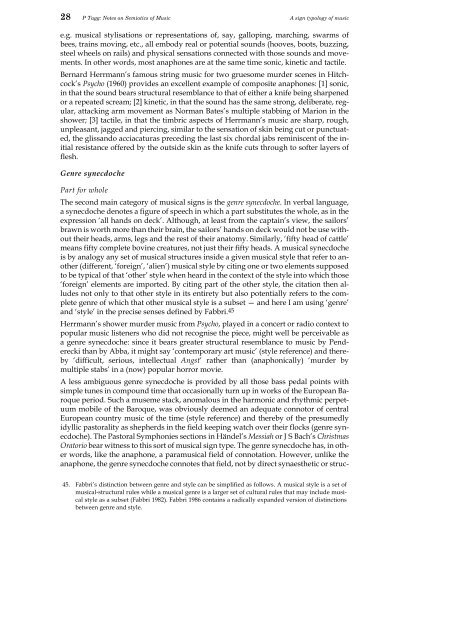Introductory notes to the Semiotics of Music - Philip Tagg's home page
Introductory notes to the Semiotics of Music - Philip Tagg's home page
Introductory notes to the Semiotics of Music - Philip Tagg's home page
You also want an ePaper? Increase the reach of your titles
YUMPU automatically turns print PDFs into web optimized ePapers that Google loves.
28 P Tagg: Notes on <strong>Semiotics</strong> <strong>of</strong> <strong>Music</strong> A sign typology <strong>of</strong> music<br />
e.g. musical stylisations or representations <strong>of</strong>, say, galloping, marching, swarms <strong>of</strong><br />
bees, trains moving, etc., all embody real or potential sounds (hooves, boots, buzzing,<br />
steel wheels on rails) and physical sensations connected with those sounds and movements.<br />
In o<strong>the</strong>r words, most anaphones are at <strong>the</strong> same time sonic, kinetic and tactile.<br />
Bernard Herrmann’s famous string music for two gruesome murder scenes in Hitchcock’s<br />
Psycho (1960) provides an excellent example <strong>of</strong> composite anaphones: [1] sonic,<br />
in that <strong>the</strong> sound bears structural resemblance <strong>to</strong> that <strong>of</strong> ei<strong>the</strong>r a knife being sharpened<br />
or a repeated scream; [2] kinetic, in that <strong>the</strong> sound has <strong>the</strong> same strong, deliberate, regular,<br />
attacking arm movement as Norman Bates’s multiple stabbing <strong>of</strong> Marion in <strong>the</strong><br />
shower; [3] tactile, in that <strong>the</strong> timbric aspects <strong>of</strong> Herrmann’s music are sharp, rough,<br />
unpleasant, jagged and piercing, similar <strong>to</strong> <strong>the</strong> sensation <strong>of</strong> skin being cut or punctuated,<br />
<strong>the</strong> glissando acciacaturas preceding <strong>the</strong> last six chordal jabs reminiscent <strong>of</strong> <strong>the</strong> initial<br />
resistance <strong>of</strong>fered by <strong>the</strong> outside skin as <strong>the</strong> knife cuts through <strong>to</strong> s<strong>of</strong>ter layers <strong>of</strong><br />
flesh.<br />
Genre synecdoche<br />
Part for whole<br />
The second main category <strong>of</strong> musical signs is <strong>the</strong> genre synecdoche. In verbal language,<br />
a synecdoche de<strong>notes</strong> a figure <strong>of</strong> speech in which a part substitutes <strong>the</strong> whole, as in <strong>the</strong><br />
expression ‘all hands on deck’. Although, at least from <strong>the</strong> captain’s view, <strong>the</strong> sailors’<br />
brawn is worth more than <strong>the</strong>ir brain, <strong>the</strong> sailors’ hands on deck would not be use without<br />
<strong>the</strong>ir heads, arms, legs and <strong>the</strong> rest <strong>of</strong> <strong>the</strong>ir ana<strong>to</strong>my. Similarly, ‘fifty head <strong>of</strong> cattle’<br />
means fifty complete bovine creatures, not just <strong>the</strong>ir fifty heads. A musical synecdoche<br />
is by analogy any set <strong>of</strong> musical structures inside a given musical style that refer <strong>to</strong> ano<strong>the</strong>r<br />
(different, ‘foreign’, ‘alien’) musical style by citing one or two elements supposed<br />
<strong>to</strong> be typical <strong>of</strong> that ‘o<strong>the</strong>r’ style when heard in <strong>the</strong> context <strong>of</strong> <strong>the</strong> style in<strong>to</strong> which those<br />
‘foreign’ elements are imported. By citing part <strong>of</strong> <strong>the</strong> o<strong>the</strong>r style, <strong>the</strong> citation <strong>the</strong>n alludes<br />
not only <strong>to</strong> that o<strong>the</strong>r style in its entirety but also potentially refers <strong>to</strong> <strong>the</strong> complete<br />
genre <strong>of</strong> which that o<strong>the</strong>r musical style is a subset — and here I am using ‘genre’<br />
and ‘style’ in <strong>the</strong> precise senses defined by Fabbri. 45<br />
Herrmann’s shower murder music from Psycho, played in a concert or radio context <strong>to</strong><br />
popular music listeners who did not recognise <strong>the</strong> piece, might well be perceivable as<br />
a genre synecdoche: since it bears greater structural resemblance <strong>to</strong> music by Penderecki<br />
than by Abba, it might say ‘contemporary art music’ (style reference) and <strong>the</strong>reby<br />
‘difficult, serious, intellectual Angst’ ra<strong>the</strong>r than (anaphonically) ‘murder by<br />
multiple stabs’ in a (now) popular horror movie.<br />
A less ambiguous genre synecdoche is provided by all those bass pedal points with<br />
simple tunes in compound time that occasionally turn up in works <strong>of</strong> <strong>the</strong> European Baroque<br />
period. Such a museme stack, anomalous in <strong>the</strong> harmonic and rhythmic perpetuum<br />
mobile <strong>of</strong> <strong>the</strong> Baroque, was obviously deemed an adequate conno<strong>to</strong>r <strong>of</strong> central<br />
European country music <strong>of</strong> <strong>the</strong> time (style reference) and <strong>the</strong>reby <strong>of</strong> <strong>the</strong> presumedly<br />
idyllic pas<strong>to</strong>rality as shepherds in <strong>the</strong> field keeping watch over <strong>the</strong>ir flocks (genre synecdoche).<br />
The Pas<strong>to</strong>ral Symphonies sections in Händel’s Messiah or J S Bach’s Christmas<br />
Ora<strong>to</strong>rio bear witness <strong>to</strong> this sort <strong>of</strong> musical sign type. The genre synecdoche has, in o<strong>the</strong>r<br />
words, like <strong>the</strong> anaphone, a paramusical field <strong>of</strong> connotation. However, unlike <strong>the</strong><br />
anaphone, <strong>the</strong> genre synecdoche con<strong>notes</strong> that field, not by direct synaes<strong>the</strong>tic or struc-<br />
45. Fabbri’s distinction between genre and style can be simplified as follows. A musical style is a set <strong>of</strong><br />
musical-structural rules while a musical genre is a larger set <strong>of</strong> cultural rules that may include musical<br />
style as a subset (Fabbri 1982). Fabbri 1986 contains a radically expanded version <strong>of</strong> distinctions<br />
between genre and style.














